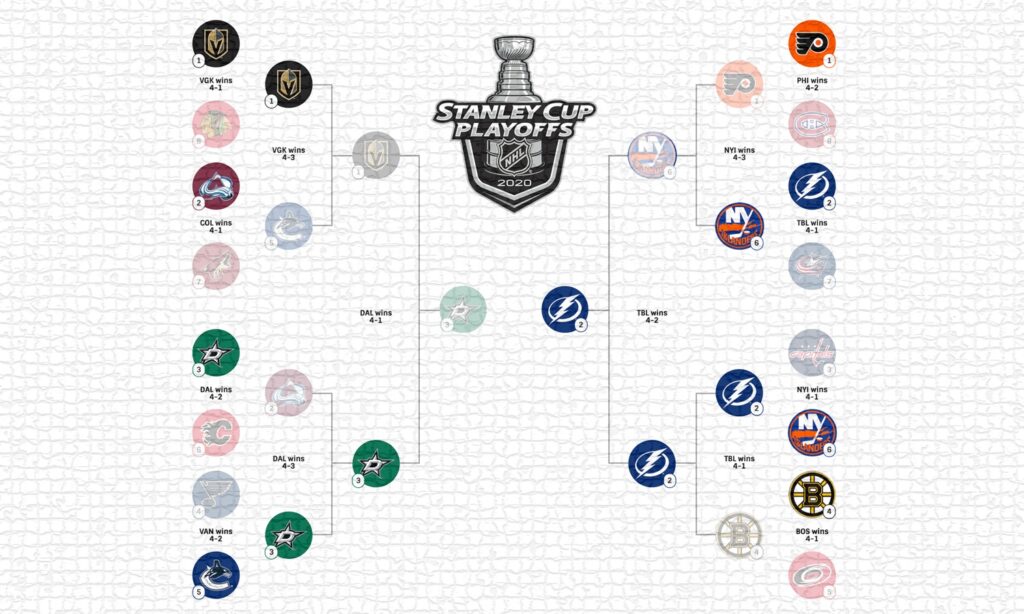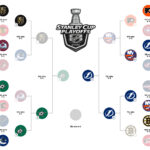Your palms are getting sweaty, your stress levels are high, and you start endlessly looking up predictions from your favorite and not-so-favorite hockey pundits.
That’s right, the playoffs are right around the corner.
Some teams have been qualified for the Stanley Cup Playoffs weeks in advance, while others just squeaked on in.
Now that the teams are set, you might have asked yourself how did we get here and what should we expect?
Let’s start with the burning question.
How do NHL Playoffs Work?
There are sixteen teams that qualify in a 4-round, best-of-7 elimination series in the NHL Playoffs. The first team to reach 4 wins in their series matchup continue onto the next round. The winner in the final round is crowned as the Stanley Cup Champions.
In order to understand how teams can reach the NHL playoffs, let’s me explain how the league is structured.
The league is divided into two conference: Eastern & Western Conference.
As you probably expect, teams are separated based on their time zones, regardless whether the city is located in United States or Canada. There are currently 32 NHL teams, with the Seattle Kraken the latest to join the league (2021).
Furthermore, each conference is divided into 2 divisions: Metropolitan & Atlantic (Eastern), Central & Pacific (Western).
The division name is gives you even a better hint at where these teams are located on the map.
There are now four divisions with 8 teams. The Seattle Kraken were added to the Pacific division, while another was moved out of the Pacific division.
So, which team will moved to the Central division with Seattle Kraken joining the Pacific?
The Arizona Coyotes
At this point, you must be saying this is all fine and dandy, but which teams make the playoffs?
Let’s cut to the chase - the top three teams in each division are guaranteed a playoff spot.
However, these teams only account for 6 of 8 playoffs spots for each conference. So, how are the final spots filled?
NHL Wild Card Spots
The final spots in each conference are known as Wild Card spots. They are awarded to the top 2 teams in the conference outside of the existing 6 divisional qualifiers.
NHL Eastern Conference (Wild Card)

NHL Western Conference (Wild Card)

In case you were wondering, it is possible for those 2 spots to be filled by teams in the same division.
Furthermore, it’s also possible for the Wild Card teams to have more points than 1 or more teams of a divisional qualifier.
And lastly, there is also the outside chance that a team excluded from the playoffs may have finished with more points than a Divisional qualifier.
So, for those questioning, it’s not necessarily the top 16 teams that make the playoffs. Nor is it always the top 8 teams from each conference.
Team Rankings for NHL Playoffs
Once all 16 teams are qualified for the playoffs, they are sorted by their divisional standings.
That is, Divisional Qualifiers are ranked 1 through 3 in their respective divisions. Moreover, each division invites a Wild Card team to qualify in the #4 position.
The divisional teams ranked 2 and 3 face are always guaranteed to face each other in the 1st round.
So, which Wild Card team is paired with the top seeds of each division?
The team finishing with the most points in the conference - the better of the two top seeded divisional teams - plays against the weaker wild card team.
Which means that the other divisional leader plays against the higher-ranked wild card finisher.
Before we break down each round of the playoffs, take note of the game structure for each series.
The higher-seeded team of each matchup receives home-ice advantage. Since it’s a best-of-7-games series, this is how their games are scheduled:
Playoff Series Schedule Format
Games 1 & 2 at home
Games 3 & 4 on the road
Game 5 at home (if necessary)
Game 6 on the road (if necessary)
Game 7 at home (if necessary)
This is also known as the 2–2–1–1–1 playoff format, and it applies throughout all playoff series.
Overtime Rules during the Playoffs
Also, if you thought that 3-on-3 overtime followed by shootout was employed in the Stanley Cup Playoffs, you were wrong. Those rules only apply to regular season games.
In the playoffs, teams play “sudden-death” overtime. The game ends the moment either team scores to break the tie.
Overtime periods are each 20-minutes long with intermissions reduced to 15 minutes. As a reminder, intermissions between the 1st and 2nd periods are 18 minutes.
If you’re wondering what the longest game in NHL history is, make sure to check out my blog post on How Long is Overtime in Hockey?
Hint: It was equivalent to almost 3 full regulation games.
NHL Playoff Rounds Explained
With 16 teams qualifying in the NHL playoffs each year, the Stanley Cup finals are made up of 4 playoff rounds.
Below, I breakdown how each round works and which team is granted home ice advantage at every stage.
NHL Quarter Finals (Round 1)
The first round of the playoffs is also referred to as the Quarter Finals. With 16 teams starting their playoff journey, there are 8 total matchups.
Teams are typically given 2-3 days off between games, but there are exceptions in case of venue conflict.
Sometimes there are concerts or other sporting events scheduled that may interfere with the NHL playoff games.
Furthermore, some of the series may finish early (team wins by 4-game sweep), while others may carry out the full 7 games.
In that case, the early winners will have to wait until the 1st round is complete for all teams.
NHL Semi Finals (Round 2)
Once the first round is over, the two winners in each division face off against one another.
In fact, there are 4 possible outcomes for divisional matchups in round 2:
#1 Seed vs #2 Seed
#1 Seed vs #3 Seed
#2 Seed vs #4 Seed
#3 Seed vs #4 Seed
There are only 8 teams remaining in Round 2.
As in the first round, teams must wait for the outcome of the other matchups to continue on.
NHL Conference Finals (Round 3)
The Conference Finals is where the winners of each division square off. That is, the two remaining teams of each conference play one another.
At this point, only 4 teams remain in the playoffs altogether.
The winners of each conference are titled as the Eastern Conference and Western Conference Champions respectively.
The Eastern team is rewarded with Prince of Wales trophy, while the Western team earns the Clarence S. Campbell Bowl.
Since the 1997 finals, there’s been an NHL superstition that players should avoid touching the conference championship or risk losing in the Stanley Cup finals.
It was following the series between the Philadelphia Flyers and the New York Rangers the superstition emerged.
The Flyers won the series and Eric Lindros refused to touch the Prince of Wales trophy. The thinking was that you haven’t won anything until you actually win the Stanley Cup.
However, in the Western Conference, Captain Steve Yzerman of the Detroit Red Wings opted to touch the Clarence S. Campbell Bowl.
The Red Wings went on to win the Stanley Cup that year (1996-97).
The reality is that close to half the teams whose players touched the conference trophies have also won the Stanley Cup championship.
But if you witness this in either of the conference series this year, at least you know the back story.
NHL Stanley Cup Finals (Round 4)
The Stanley Cup Finals present one last dilemma.
We know which teams are going to square off, but who actually gets home-ice advantage? What if the Eastern team finished 1st in points in their conference, while the Western team finished 2nd in points in theirs?
The answer is actually simple. The team who finished with the most points in the overall (league) standings earns home-ice advantage.
(source)
It’s possible that both teams finished equal in team points, but the league tie-breaker applies. Again, if you want to understand how tie-breakers are settled for teams equal in points, make sure to check out my blog post on Hockey Standings Explained Column by Column.
The winner of the series is crowned the Stanley Cup champions.
Players who played at least 41 regular season games or 1 one game in the Stanley Cup Finals for the winning team get their names engraved on the cup.
There is also a hard limit of 52 names that can make it on the cup for each year.
When do NHL Playoffs Start?
The NHL Playoffs start in mid-April at the conclusion of the regular season. The league gives a few days break before the first playoff game is played.
There are many factors to this pause in play:
- 1Teams may not know who they will play in the first round, or if they will even qualify for the playoffs until the very last regular season game.
- 2To allow teams enough time to travel to their rival's destination
- 3To allow teams to practice and strategize against their match-up
- 4Give players a brief recovery period to heal minor injuries for the playoffs
Final Thoughts
While simple in format, the NHL playoffs are, once again, the only league to offer four equal rounds of a best-of-seven series for 16 teams out the gate.
Meanwhile, the NBA and MLB have tinkered with their playoff format recently.
The NBA uses a play-in tournament, giving a chance to the 9th and 10th seeds in each conference a final shot at qualifying for the playoffs.
In the end, 16 NBA teams make it to the playoffs playing a best-of-seven series each round.
As for the MLB, they have increased their playoff qualifiers from 10 to 12 teams. The top 2 teams of each league are given a first-round bye.
The remaining teams, known as the Wild Cards, duke it out in a three-game series for the first round.
The winners of the Wild Card series advance to the semi-finals where 8 teams remain.
These teams play up to three elimination rounds of a best-of-seven series.
Coming back to the NHL, I think there are two main reasons why they keep the playoff structure as is.
One is the hard salary cap. Given that NHL teams have a min/max spending range, lower ranked teams remain competitive.
You hear about unsuspecting teams making a fairy tale run in the series.
The second reason is that NHL team rosters are quite large. So, although the NBA has a salary cap in place, their active roster is made up of 13-14 players max each game.
Furthermore, the starting NBA players will play the majority of the game, granted their not in foul trouble.
As for the NHL, your active roster is made up of 20 players.
Aside from the goalie, your star players will play around 30-40% of total game time.
In essence, your other lines will have an impact on the game as well. So, don't be surprised when a lower ranked team upsets the top dog in round one of the NHL playoffs.






